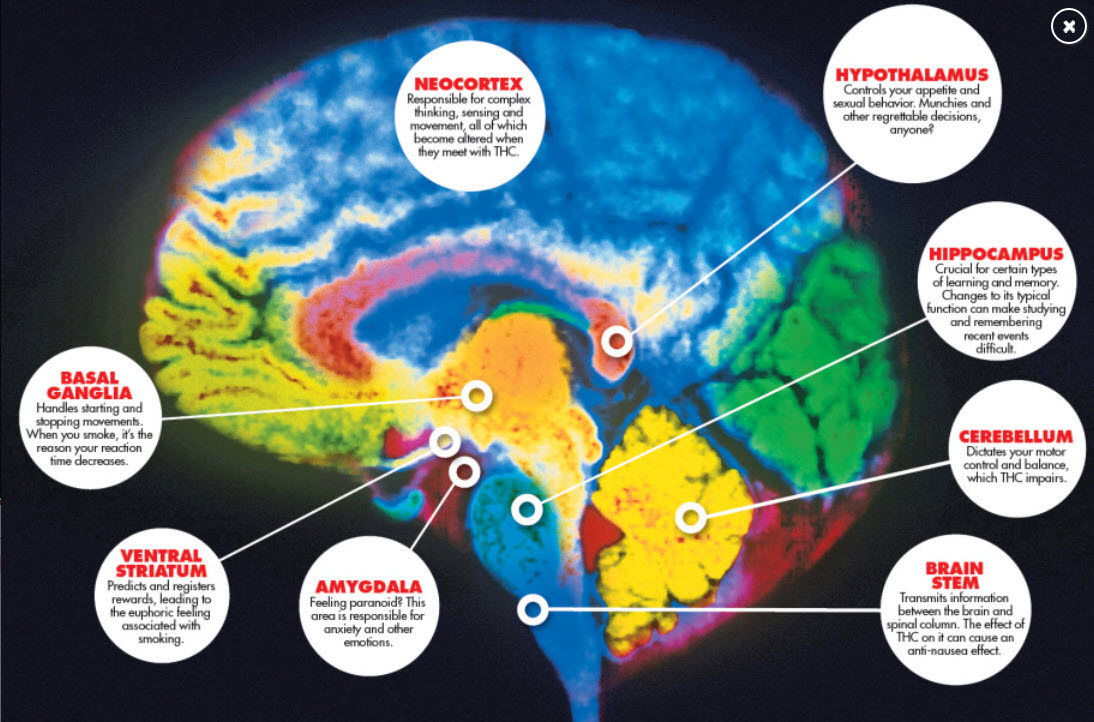All the ways marijuana can hurt your health
 New York Post 22 May 2018
New York Post 22 May 2018
Over the past six years, nine states and Washington, DC, have legalized marijuana for recreational use. By year’s end, four more are set to make smoking a joint as innocent as drinking a glass of bourbon.
Here in New York City, Mayor Bill de Blasio just called for ceasing marijuana arrests, and there’s a push for Albany to make it completely legal on the state level. Across the country, roughly six in 10 Americans (61 percent) say the use of marijuana should be legalized, according to a Pew Research Center survey in January.
But even as the country seems poised to turn into one giant pot party, there are signs that commercialized mainstreaming of weed is not all peace, love and good vibes. While marijuana has shown to be helpful in getting addicts off opioids, staving off side effects of chemotherapy and treating insomnia, among other medical benefits, there are also health, legal and societal issues popping up as governments become more permissive. The long-term effects of legalization are unknown — and potentially dangerous.
“It’s a giant experiment,” says Christian Hopfer, a professor of psychiatry at University of Colorado School of Medicine. He is co-leading a $5.5 million study of 5,000 sets of twins funded by the National Institute on Drug Abuse (NIDA) on the impact that legalization has on mental health and substance use. It’s a much-needed examination since rigorous, large-scale research has been limited.
“Smoke a couple times a day and marijuana will knock off your memory. That is pretty certain,” Hopfer says. “And there is no question that legalization has a normalizing effect on something that used to be against the law.”
Hopfer disagrees with the rationale that people will smoke weed whether or not it’s legal.
“By age 21, 98 percent of the population has had a drink. But only 10 percent of the population has tried cocaine, and 50 percent [have] tried marijuana,” he tells The Post.
Especially troubling, he says, is that younger people are most vulnerable to the downsides.
“If you start smoking pot as a teenager, you have a four times higher likelihood of getting addicted,” says Hopfer, who voted against legalization in Colorado. “The brain of a teenager is more sensitive to the effects than the brain of an adult would be. [Marijuana] is likely to have a more detrimental effect on kids.”
Plus, some argue that marijuana can be a gateway to more detrimental substances, such as cocaine and prescription pills. According to a 2015 study conducted by researchers at Yale School of Medicine, using marijuana makes a person two and a half times more likely to abuse prescription opioids.
And there is the danger of becoming addicted to marijuana itself. An estimated 3 million people suffer from marijuana use disorder. The Diagnostic and Statistical Manual of Mental Disorders defines that as significant impairment of functioning and distress, as well as symptoms such as cravings and difficulty stopping, resulting from using marijuana for at least a year.
“You can’t stop and you give up other things to keep using,” Hopfer says. “People go to work stoned and are stoned with their loved ones. Performance in life and on the job both get negatively impacted.”
Another major potential danger is an increase in cannabis-related traffic accidents and fatalities. According to an analysis by the Denver Post, the number of cannabis-related highway fatalities in Colorado has doubled since a law making recreational marijuana legal took effect in 2014. The Highway Loss Data Institute found that collisions reported to insurance companies are 2.7 percent higher in weed-legal states than in the no-smoke zones on their borders.
Also of concern is that marijuana is stronger than ever — highly profitable and scientifically grown for maximum impact.
What people are consuming now is the product of a weed “arms race,” Robert MacCoun, a drug policy expert at the University of California at Berkeley, has said.
In the 1990s, THC levels ran in the range of 3.7 to 10 percent. These days, the average potency on the Colorado market is 18.7 percent, according to a lab test.
It’s getting even higher to meet demand. “We’ve seen potency results in the high 20s to low 30s,” says Seth Wong, founder and president of TEQ Analytical Labs.
While the strength might be good news for people who like to get comatose, for the majority of smokers, it can be quite dangerous. According to a study published in the British Journal of Psychiatry in 2009, weed-driven psychotic episodes were more likely to be triggered by high-potency strains. https://www.drugabuse.gov/publications/drugfacts/nationwide-trends
https://www.drugabuse.gov/publications/drugfacts/nationwide-trends
Another study published by the Lancet in 2015 reported that patients using high-potency cannabis show a three-times increase in psychotic disorder risk.
This may not sound like much until you consider that useful medications get pulled by the FDA when similar side effects happen in one-half of 1 percent of those who take it. Additionally, says Hopfer, there are other maladies that come with heavy weed smoking.
“You lose your ability to organize information and there are weird, persistent vomiting syndromes [among serious smokers],” he says. “Marijuana represses nausea in small amounts” — and this makes the drug a godsend to people going through chemotherapy — “but it messes up your system for controlling nausea if you do too much of it. It creates persistent vomiting, and the only treatment is to stop using marijuana until the vomiting abates.”
Essentially, Hopfer says, smoking weed is like “playing Russian roulette” with your health.
The American Lung Association says that “smoke from marijuana combustion has been shown to contain many of the same toxins, irritants and carcinogens as tobacco smoke.”
Many users now favor vaping with discreet pen-like instruments, instead of actually smoking pot. While research on the long-term health effects of vaping is limited, Hopfer expresses concern that it invariably means that the brain is getting hit with a higher percentage of THC. Some oils used for vaping are also more concentrated.
Edibles have their unique drawbacks.
“The dosing is weird,” says Hopfer. “People eat them and don’t get the effect right away. So they take more and might really lose it.”
In Colorado, emergency room visits have been on the rise since the outlaw status was lifted. According to the Journal of Adolescent Health, visits to the Colorado ER by teenagers suffering from pot-related illnesses more than quadrupled between 2005 and 2015. (This increase may partly be the result of teens less fearful of getting arrested if they go to the hospital.)
When mixed with stone-cold capitalism, legalization is making the consumption of weed increasingly compelling.
“It is not unlike the tobacco industry in the 1960s,” says Hopfer. “There are marijuana-infused coffees and beers and foods … There are people who are chemically trying to modify marijuana to get you high quicker and bring you down quicker . . . You have an industry of chemists and professionals who are openly figuring out customer-pleasing formulations.”
Still, a 2015 study published in Scientific Reports found that marijuana is far less toxic than alcohol or tobacco, and concluded that its dangers “may have been overestimated.”
But Hopfer worries about potential long-term negative effects that we can’t imagine. And state legislatures have big issues to address when it comes to legalization, from age limits to potency labeling to managing second-hand smoke.
“Twenty years ago, we were told that opiates were fine for pain,” Hopfer says. “Now all these people are addicted. Who knows where marijuana will be in 20 years?”
Marijuana use by the numbers
- 13 Percent of adult Americans who identify as marijuana users, according to a 2016 Gallup poll.
- 7 Percent of Americans who identified as users in 2013, according to Gallup.
- 138,000 People who sought voluntary treatment for marijuana use in 2015.
- 77.44 Metric tons of marijuana consumed by New Yorkers every year, according to research from Seedo, a company that manufacturers hydroponic growing devices. That’s more than anywhere else in the world, according to the study.
- 70.3 percent The share of illicit drug users whose first illicit drug was marijuana, according to a 2013 survey.
- 6 The average loss in IQ points associated with heavy marijuana use in adolescence. Adults who smoke in their youth and then quit do not recover the points.
- 3.8 The average percent of tetrahydrocannabinol (or THC, the active chemical in marijuana) in confiscated weed in the early 1990s.
- 12.2 The average percent of THC in confiscated marijuana in the 2014.
- 54 Percent of adult marijuana users who are parents, per a Yahoo News and Marist College poll.
*all stats from drugabuse.gov, unless otherwise noted
https://nypost.com/2018/05/22/all-the-ways-marijuana-can-hurt-your-health/







